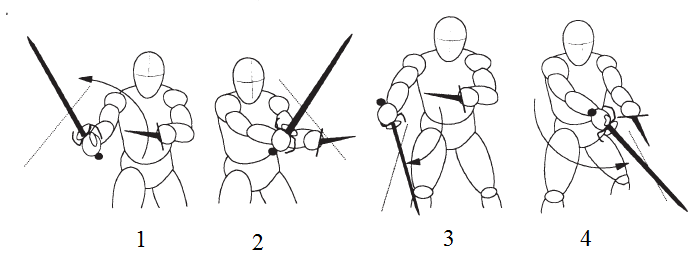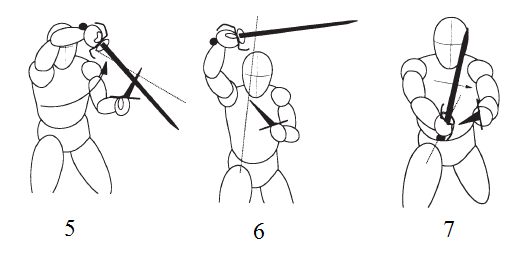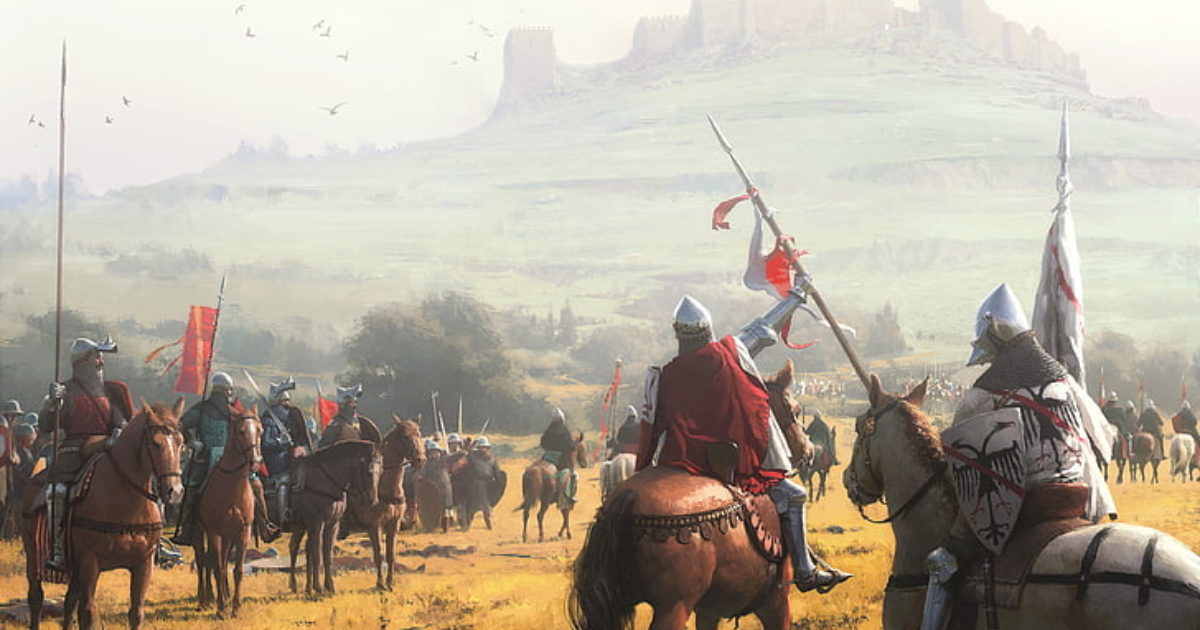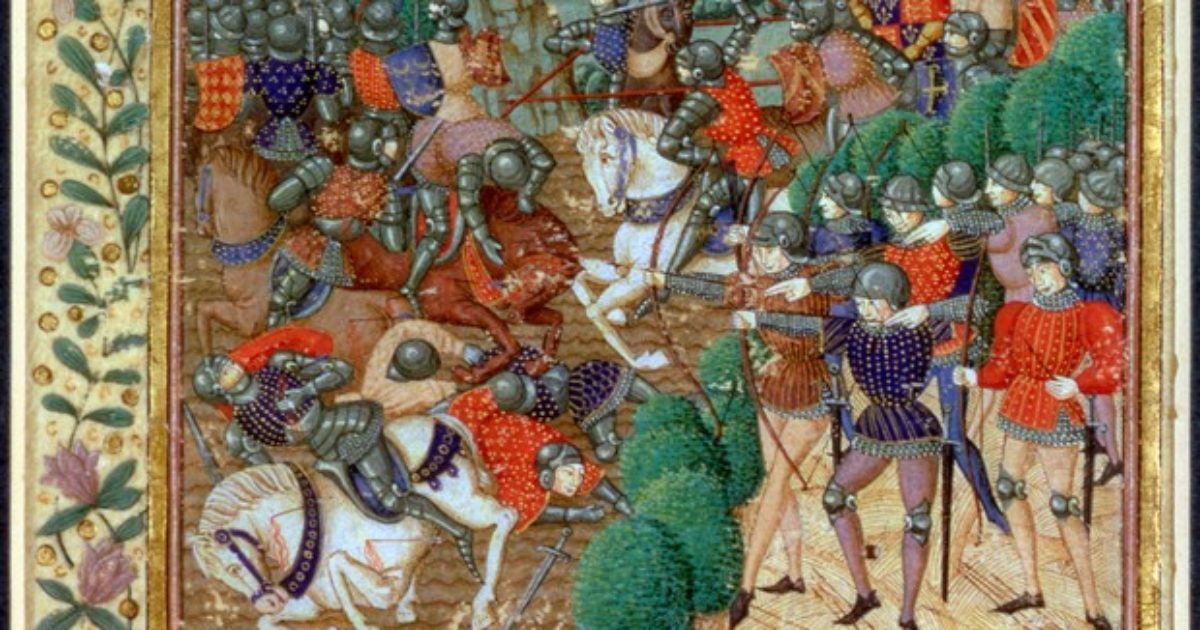
Cut-and-Thrust Fencing Beginner Course (Iron Thorn Manual 1st Edition)
Cut-and-thrust fencing is a classic renaissance style of fencing evolving from the classic medieval arming sword/sword and shield style of fighting. As the name suggests it consists of various cuts and thrusts as strikes on an opponent. This style of fencing would last from the 16th century until around the 19th century when historical fencing styles would be phased out into modern Olympic fencing with foil, epee, and sabre. Sabre fencing evolved from cut-and-thrust.
The Swords
Cut-and-thrust swords initially started around the 16th century with the Side Sword, an evolution from the medieval Arming Sword or War Sword. The side sword was similar in appearance to the rapier, but with a shorter, heavier duty blade for the style of fighting it represented. Most side swords incorporated either a full swept hilt, or a combination of the swept hilt and the cruciform hilt of earlier medieval swords (see diagrams). Later, the cut-and-thrust sword designs would evolve into the, Scottish claymore (basket-hilted variant), smallsword, cutlass, and sabres of the 17th, 18th, and early 19th centuries (see diagrams). Smallswords were often used as dueling weapons, and a symbol of status as is was popular among aristocrats, and officers in militaries. The cutlass has been made popular in pirate media, due to its widespread use as a naval sword in case of boarding, it is the heavier design along with the Scottish claymore. The sabre was designed specifically for the use of cavalry, but later would be used for fencing purposes. The final sword in the cut-and-thrust category was the Spadroon, an English designed sword that became popular around the Napoleonic Era especially among naval officers (see diagram). Most of the later cut-and-thrust swords, though no longer used as mainstream dueling weapons, are still used today in the form of dress swords for militaries.

Four Levels of Importance
- Safety-With a contact sport, one must maintain safety in order to keep people from severe injury or death.
- Honor-The game does not work without fencers acknowledging shots. And proclaiming if a shot was bad.
- Attitude-Without an attitude of fun, the game is no longer fun for you or those around you, maintain a good attitude, and if you find yourself getting frustrated, leave the fight and calm down.
- Skill-One should always seek to practice and hone their skills.
Protective Gear
As with all contact fencing sports, cut-and-thrust has its own protective gear. As a cut-and-thrust fencer you should find your protective gear for your own safety and wellbeing. Below is a list of required and recommended protective gear.
- Required
- Protective Mask (Including back of head protection)
- Padded or armored gloves
- Elbow Pads
- Knee Pads
- Forearm Protection
- Gorget that covers the Collarbone
- Recommended
- Padded chest protection
- Shin Protection
The Stance
The cut-and-thrust stance is a simple fighting stance, similar to rapier if one is familiar. The placement of the feet is shoulder width apart with the same foot as your fighting arm being forward (right foot if you are fighting right-handed, left foot if you are fighting left-handed) with the opposite slightly at an angle behind. See Figure.
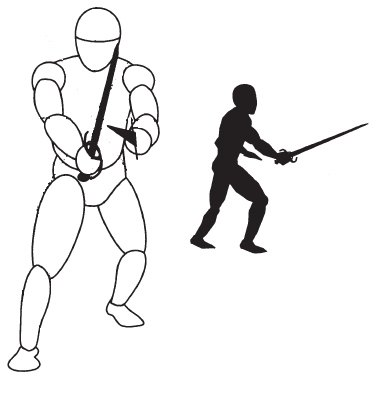
Holding the Sword
Holding the sword and off-hand in cut-and-thrust is very similar to rapier, if one is familiar with rapier. Your arm should stretch out from your body, with a slight bend in the elbow. The hilt should be center with your body with the blade point slightly off point of your opponent. The off-hand should be kept to your side, with its own bend to the elbow. Gripping a cut-and-thrust blade, one may either hold the hilt with a Italian fencing grip, or by fingering the crossguard.

Parts of the Blade
The blade consists of two parts, the Forte, and the Foible. The Forte, is the larger, stronger part of the blade closer to the hilt. The foible is closer to the tip, and is the weaker part of the blade in regards to fencing. In fencing, it is best to parry with the Forte, as it being the stronger part of the blade it will be stronger in a parry, especially against the Foible. The Foible should be used for attacks, as with cut-and-thrust fencing the primary attacks are cuts. Pure and clean cuts come from the Foible.

Cutting
To reiterate, the cut is the primary attack for cut-and-thrust. All strikes should start and end where your hilt is. The blade may shift from left to right in regards to being online, but that applies with the natural movement of the blade. The reason for the return, is to allow yourself the ability to parry after a cut, or to proceed and cut again. Basic cuts are as follows:
- Left to Right
- Diagonal downward
- Horizontal left to right
- Diagonal Upward
- Right to Left
- Diagonal downward
- Horizontal right to left
- Diagonal Upward
- Vertical
- Downward
- Upward
When cutting, the Foible should come down across your opponent in whatever strike zone you hit, the hilt should return to its original position while the blade follows through, if enough time, return the blade online, however if one needs to parry, then parry. Figure one follows the circular formation that the sword hand should move when cutting, figure two follows the basic lines of cuts, and figure three shows the targets for the major cuts against your opponent.

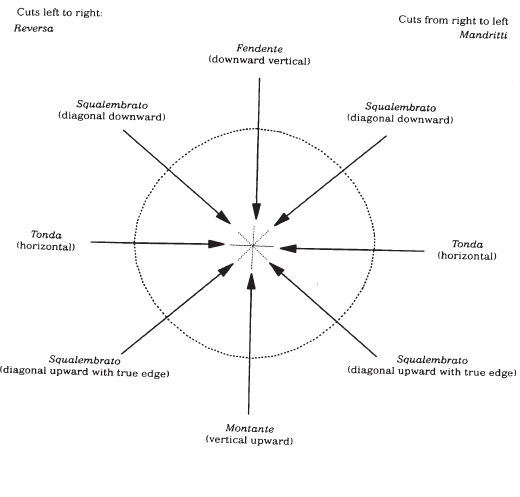

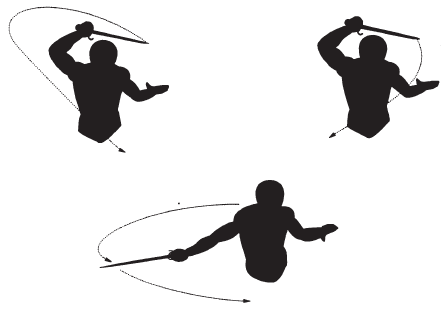
Parrying
Parries or blocks are the defensive tactic when fencing in cut-and-thrust. The concept of parrying isn’t just a simple block, more of deflect and evade. A proper parry in cut-and-thrust is to deflect your opponent’s blade away from you, and step to evade, which if done properly allows you to retaliate in turn. The figures below show each parry in order (1-7).
